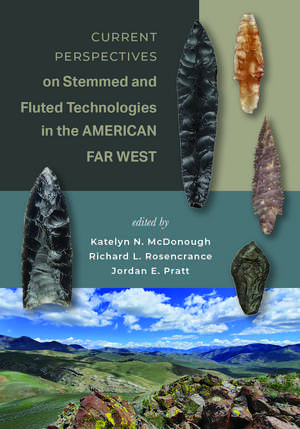Current Perspectives on Stemmed and Fluted Technologies in the American Far West
Editat de Katelyn N McDonough, Richard L Rosencrance, Jordan E Pratten Limba Engleză Hardback – 10 mai 2024
Contributions are organized into three main sections: stemmed point technologies, fluted point technologies, and broader interactions. Topics range from regional overviews of chronologies and technologies to site-level findings containing extensive new data. The culmination of many years of work by dozens of researchers, this volume lays new groundwork for understanding technological innovation, diversity, and exchange among early Indigenous peoples in North America.
Preț: 486.96 lei
Preț vechi: 572.89 lei
-15% Nou
Puncte Express: 730
Preț estimativ în valută:
93.18€ • 97.56$ • 77.29£
93.18€ • 97.56$ • 77.29£
Carte indisponibilă temporar
Doresc să fiu notificat când acest titlu va fi disponibil:
Se trimite...
Preluare comenzi: 021 569.72.76
Specificații
ISBN-13: 9781647691431
ISBN-10: 1647691435
Pagini: 340
Ilustrații: 35 illustrations, 26 color illustrations
Dimensiuni: 178 x 254 x 28 mm
Greutate: 0.86 kg
Editura: University of Utah Press
Colecția University of Utah Press
ISBN-10: 1647691435
Pagini: 340
Ilustrații: 35 illustrations, 26 color illustrations
Dimensiuni: 178 x 254 x 28 mm
Greutate: 0.86 kg
Editura: University of Utah Press
Colecția University of Utah Press
Recenzii
“This volume provides a valuable snapshot of early lithic technologies in western North America and the relationships of those technologies to other early stone tools and manufacturing techniques in the rest of the continent.”
—David B. Madsen, Texas Archaeological Research Laboratory
—David B. Madsen, Texas Archaeological Research Laboratory
Notă biografică
Katelyn McDonough is an assistant professor in the department of anthropology, director of the Museum of Natural and Cultural History’s Archaeology Field School, and curator of Great Basin Archaeology at the University of Oregon. Her research examines relationships between people, foodways, and environment in western North America, with an emphasis on plant use and landscape change during the Pleistocene-Holocene transition.
Richard (Richie) Rosencrance is a Ph.D. candidate in Anthropology and with the Artemisia Archaeological Research Fund at the University of Nevada, Reno, and an instructor at the Archaeology Field School run by the Museum of Natural and Cultural History at the University of Oregon. His research focuses broadly upon technological innovation, especially in the northern Great Basin and Columbia Plateau, and more specifically upon late Pleistocene lithic technology and chronology building.
Jordan Pratt is a Ph.D. candidate in Anthropology and with the Center for the Study of the First Americans at Texas A&M University. She is currently leading excavations at Weed Lake Ditch, an open-air Paleoindian site in eastern Oregon. Her research centers on the lithic technological organization strategies used by late Pleistocene peoples, particularly in the northern Great Basin.
Richard (Richie) Rosencrance is a Ph.D. candidate in Anthropology and with the Artemisia Archaeological Research Fund at the University of Nevada, Reno, and an instructor at the Archaeology Field School run by the Museum of Natural and Cultural History at the University of Oregon. His research focuses broadly upon technological innovation, especially in the northern Great Basin and Columbia Plateau, and more specifically upon late Pleistocene lithic technology and chronology building.
Jordan Pratt is a Ph.D. candidate in Anthropology and with the Center for the Study of the First Americans at Texas A&M University. She is currently leading excavations at Weed Lake Ditch, an open-air Paleoindian site in eastern Oregon. Her research centers on the lithic technological organization strategies used by late Pleistocene peoples, particularly in the northern Great Basin.
Descriere
Exploring how stone tools provide insight into the initial settlement of the Americas
